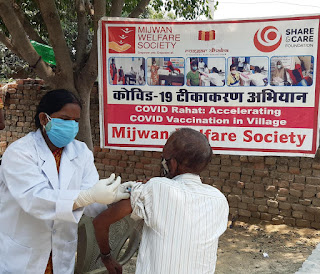Ever since its inception, Mijwan Welfare Society has been on
a mission to create an inclusive society driven towards self-reliance through
sustainable development. To realize this
goal, Mijwan Welfare Society has heavily invested its time and resources in
empowering the most vulnerable individuals residing in underdeveloped villages
through the plethora of programs it has initiated like Rozgar Dhaba and
Saksham, which have seen enormous success, and are nothing but a testament to
their vision. With the use of education, training, and employment, the
organization has been committed to supporting these villagers, especially the
girl child, to set up their own small-scale businesses and industries. Mijwan
Welfare Society believes that it is through such self-reliant empowerment that
the underprivileged have a chance at realizing a life of growth and
fulfillment.
This vision of Mijwan Welfare Society cannot be better told than
through the inspiring story of Dhanvanti Devi. A humble resident of village
Krishnapuri, Dhanvanti Devi had suffered through a life of hardships. Already
struggling from physical disabilities in her legs, she was widowed soon after
her marriage. Dhanvanti Devi’s husband had passed away and had left behind his
children in the care of his disabled wife. Even before such misery, Dhanvanti
Devi was very poor and could not afford to live in a house, hence she resided
in a humble hut made of hay. Still, her resilience could not be doubted. As the
sole earner of her family, she managed her household on a meager salary that
she earned through her work as a helper in an Anganwadi. However, an issue
arose after she was unable to withdraw her salaries. As it was prescribed by
the regulations, all her income from the Anganwadi was automatically credited
to her bank account. As she did not have a PAN card to her name, she was not
authorized to own an ATM card, without which she could not access any of the
salaries she had earned throughout her time working. Dhanvanti tried her best
to get any help in this regard but due to her disabilities, she could not do
much. Also, any person who did agree to help would always overcharge her for
their services, and as she was already struggling financially, she,
unfortunately, could not afford such help.
Mijwan Welfare Society, through their Rozgar Dhaba program,
eventually found Dhanvanti and committed themselves in helping her in every way
possible. With Rozgar Dhaba, Mijwan Welfare Society provided her with ration
for her household and, as it was the cold month of January, warm blankets so
that she could keep herself and her children warm and could continue her work
without any fear. After coming to know about her troubles with accessing her
bank account and with acquiring a PAN Card, Mijwan Welfare Society worked
tirelessly to help Dhanvanti with the same. As it was before, whenever
Dhanvanti used to visit banks herself, bank employees instead of helping would always
harass her by asking her to visit different branches of the bank. Realizing
this, Mijwan Welfare Society decided to step in and facilitated meetings with
bank managers in order to complete all the necessary documentation like KYC
and, ultimately, provided Dhanvanti with her very own ATM card and access to
her bank account. Even though all of her immediate problems were taken care of,
Mijwan Welfare Society did not rest in ensuring a better future for her and her
children. They educated Dhanvanti on the various schemes by the government,
especially the Sukanya Samriddhi Yojana, that would help her girl and her
household ensure a financially secure future. For the same, Mijwan Welfare
Society visited the post office along with Dhanvanti and opened up an account
for her girl child so that she could take advantage of this scheme and achieve
financial stability later in life.
It is for stories like these that Mijwan Welfare Society
exists. The organization and its members have devoted all their attention
through their various programs to ensure that any other individual who may be
in a similar position like Dhanvanti Devi, can achieve their dreams and have a
life that is secure from all social and economic evils.








